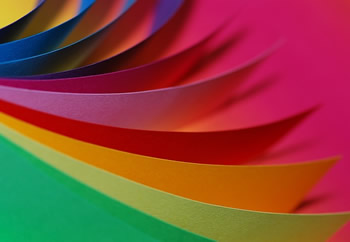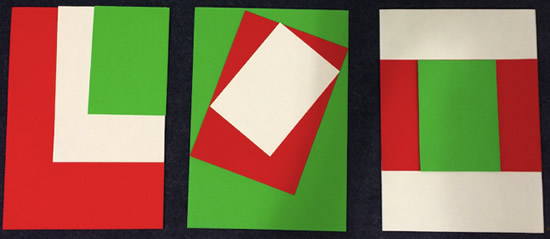Or search by topic
Number and algebra
Geometry and measure
Probability and statistics
Working mathematically
Advanced mathematics
For younger learners
Paper Partners



- Problem
- Getting Started
- Student Solutions
- Teachers' Resources
Paper Partners

You will need some different sizes and colours of paper to begin this task - three different sizes and perhaps two or three different colours.
With a partner, decide how you would describe each piece of paper. You might like to think about the words you would use to describe the size and the colour of it.
Take it in turns to ask your partner to give you a particular piece of paper by describing it (no pointing allowed!). For example, "Please pass me the large blue piece of paper"; "I would like the small red piece of paper".
Next try making a pattern with two of the pieces and then ask your partner if they can copy it.
For an extra challenge you could describe the pattern to your partner (without showing them) and then ask them to make it. For example, "Put the small blue piece of paper on top of the large red piece of paper so that they are the same way round."
We would love to see photos of your patterns and to know how you described them!
Why do this problem?
This activity provides children with the chance to develop their visualisation skills, their descriptive and positional language and collaborative ways of working together.
Possible approach
Begin with piles of A4, A5 and A6 paper in two/three different colours at the front of the room. Hold up a piece of paper and ask the children to think (silently on their own) about how they would describe this piece. Then in a pair encourage them to talk about their ideas. Finally ask them to share their ideas with the rest of the class. Do this several times,
hopefully drawing out the language of small, tiny, medium, large, big and the colours of the paper. A nice point to discuss is that comparing sizes makes it easier to give a label, for example medium is only obvious when seen alongside small and large. Depending on their experience, some learners may also describe the pieces of paper as rectangles but this is certainly not essential.
Next ask one child in each pair to tell their partner what size and colour of paper they are going to collect from the piles at the front and then do so. This continues until each pair has three different sizes of each colour in front of them.
Now you play a “1, 2, 3 ... show me” game where you describe a size and colour of paper (without holding up an example) and on the count of “1, 2, 3 ... show me” one of each pair holds up the piece that matches your description. You can vary this to include more than one piece of paper e.g. “One of you hold up the medium blue piece and the other person hold up the small red
piece.” Or you could give a negative instruction e.g. “Hold up a piece that isn't large or blue” etc.
You could then introduce the challenge as in the problem.
Key questions
What size piece are you holding? How do you know? (Can they compare it to justify the small/medium/large -ness of it?)
Which size don't you have yet?
What is the same/different about these two pieces of paper?
Possible extension
Use a box without a lid (the boxes that photocopier paper comes in are ideal) place several pieces of paper inside it, arranged in a particular way (some challenging ideas shown below) and then invite one of each pair to come and look down into the box. They must think about how to describe what they can see and then return to their partner (with hands on heads to prevent doing or
pointing) and try to get them to recreate what was in the box e.g. “The small red piece is in the middle of the large blue piece, facing the same way”.

Possible support
Encourage children to place their pieces of paper in groups when they are fetching the different sizes and colours, to help determine how many large/small, red/blue pieces they have and which sizes and colours they have yet to collect. Ordering the pieces by size once they have them all, might help children pick out a particular size and colour more easily too.
You may also like
Let's Investigate Triangles
Vincent and Tara are making triangles with the class construction set. They have a pile of strips of different lengths. How many different triangles can they make?

